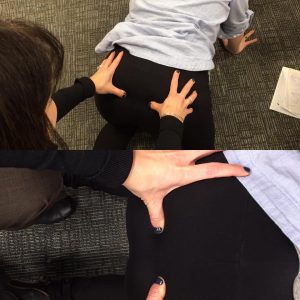Tension in the sacrotuberous ligaments hinders pelvic mobility, causes misalignment of the pelvis, sacrum, or coccyx & may result in tension in the pelvic floor muscles, hamstrings,or cause compression to the pudendal nerve. This results in less efficient vaginal delivery/childbirth, low back pain, or pelvic pain. In this image an external palpation of the sacrotuberous ligaments in all-fours position is achieved. This image is taken while attending a seminar on breech position in pregnancy. Other positions to assess the ligaments might be prone (our pregnancy treatment tables have removable belly cushions) or prone (face down) for non-pregnant women/men. We compare both right and left sacrotuberous ligaments for differences in tension, length & mobility. In pelvic pain usually one side is tighter/shorter. Assessing the position of the ischial tuberosities or sits bones can be achieved in this position. This can reveal asymmetry of the ilium/large pelvic bones. Asymmetry of the pelvic bones can be a main contributor to pubic pain, sacroiliac pain, pudendal nerve irritation/symptoms, groin/hip pain, pelvic floor muscle dysfunction, pelvic and abdominal muscle imbalances, piriformis syndrome, pregnancy round ligament pain, vulvovaginal pain, clitoral pain, testicular pain, & sexual pain.
Tension in the sacrotuberous ligaments can hinder pelvic outlet availability for optimal birthing. The treatment of the sacrotuberous ligaments includes myofascial release, cross friction massage, stretching of all associated lower quarter muscles, & strain-counterstrain positional releases. Once the ligaments achieve normal length then the pelvis can be addressed via joint mobilization to correct its alignment. Many pelvic pain symptoms resolve when correcting the ligamentous length, pelvic joint alignment and mobility, & improving muscle balance. Also, pregnant patients then have a better chance of optimal pelvic outlet opening for vaginal delivery success. These ligaments can also be tense from pelvic trauma incurred during vaginal delivery thus we address them at the post partum physical therapy visit as well.




